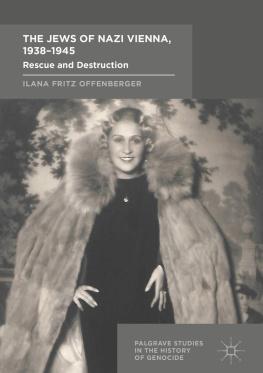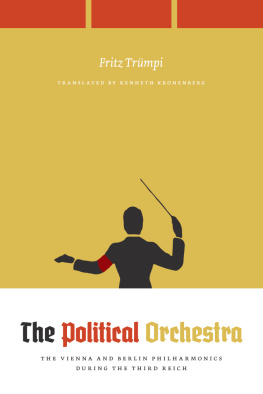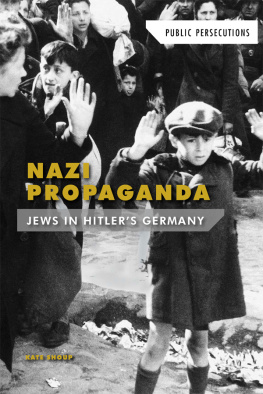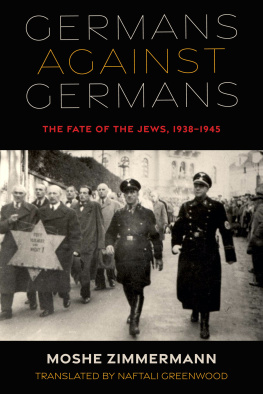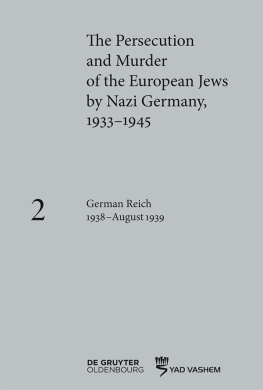Ilana Fritz Offenberger - The Jews of Nazi Vienna, 1938-1945: Rescue and Destruction
Here you can read online Ilana Fritz Offenberger - The Jews of Nazi Vienna, 1938-1945: Rescue and Destruction full text of the book (entire story) in english for free. Download pdf and epub, get meaning, cover and reviews about this ebook. publisher: Springer International Publishing, genre: Politics. Description of the work, (preface) as well as reviews are available. Best literature library LitArk.com created for fans of good reading and offers a wide selection of genres:
Romance novel
Science fiction
Adventure
Detective
Science
History
Home and family
Prose
Art
Politics
Computer
Non-fiction
Religion
Business
Children
Humor
Choose a favorite category and find really read worthwhile books. Enjoy immersion in the world of imagination, feel the emotions of the characters or learn something new for yourself, make an fascinating discovery.
- Book:The Jews of Nazi Vienna, 1938-1945: Rescue and Destruction
- Author:
- Publisher:Springer International Publishing
- Genre:
- Rating:5 / 5
- Favourites:Add to favourites
- Your mark:
- 100
- 1
- 2
- 3
- 4
- 5
The Jews of Nazi Vienna, 1938-1945: Rescue and Destruction: summary, description and annotation
We offer to read an annotation, description, summary or preface (depends on what the author of the book "The Jews of Nazi Vienna, 1938-1945: Rescue and Destruction" wrote himself). If you haven't found the necessary information about the book — write in the comments, we will try to find it.
The Jews of Nazi Vienna, 1938-1945: Rescue and Destruction — read online for free the complete book (whole text) full work
Below is the text of the book, divided by pages. System saving the place of the last page read, allows you to conveniently read the book "The Jews of Nazi Vienna, 1938-1945: Rescue and Destruction" online for free, without having to search again every time where you left off. Put a bookmark, and you can go to the page where you finished reading at any time.
Font size:
Interval:
Bookmark:
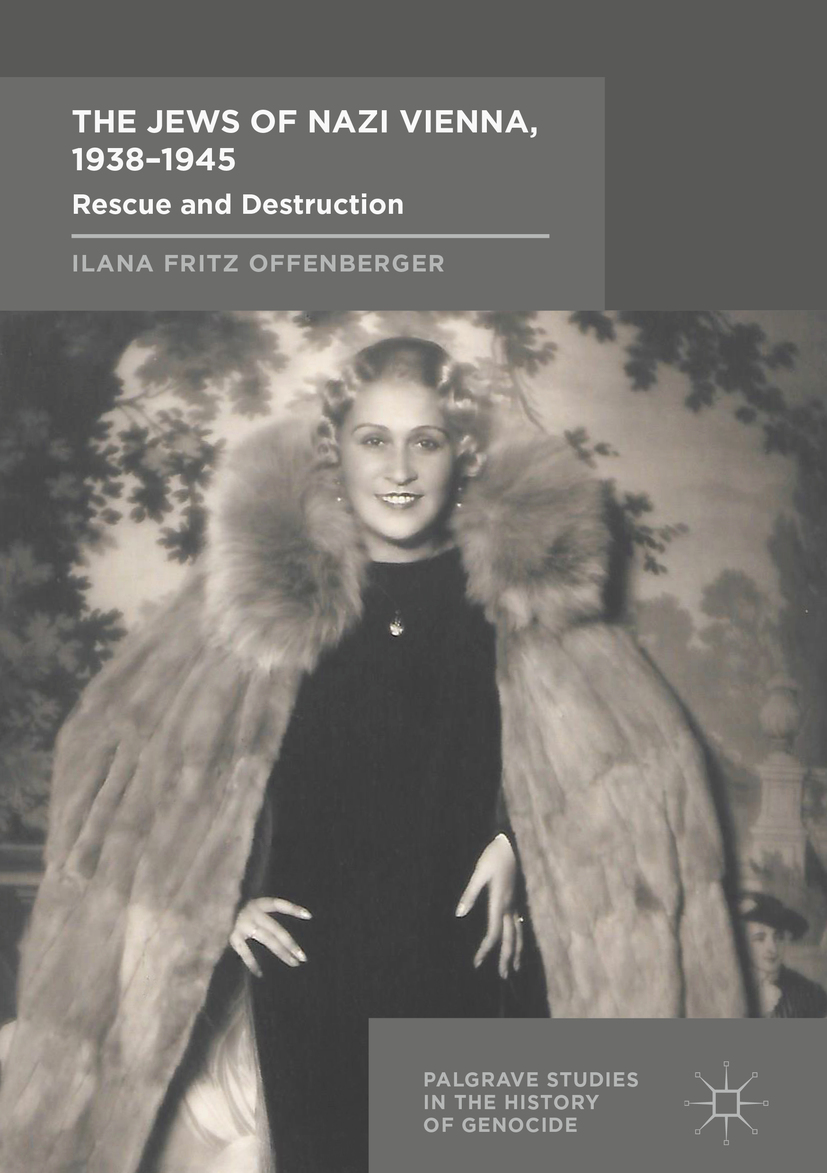
Genocide has shaped human experience throughout history and is one of the greatest challenges of the twenty-first century. Palgrave Studies in the History of Genocide is dedicated to the study of this phenomenon across its entire geographic, chronological and thematic range. The series acts as a forum to debate and discuss the nature, the variety, and the concepts of genocide. In addition to histories of the causes, course, and perpetration of genocide, the series devotes attention to genocides victims, its aftermaths and consequences, its representation and memorialization, and to genocide prevention. Palgrave Studies in the History of Genocide encompasses both comparative work, which considers genocide across time and space, and specific case studies.
More information about this series at http://www.springer.com/series/14582

Cover Image: Suzanne J. Offenberger
This Palgrave Macmillan imprint is published by Springer Nature
The registered company is Springer International Publishing AG
The registered company address is: Gewerbestrasse 11, 6330 Cham, Switzerland
For the Jews of Vienna
Those who got out,
And those who were trapped behind
Your struggle to resist Nazi oppression will not be forgotten
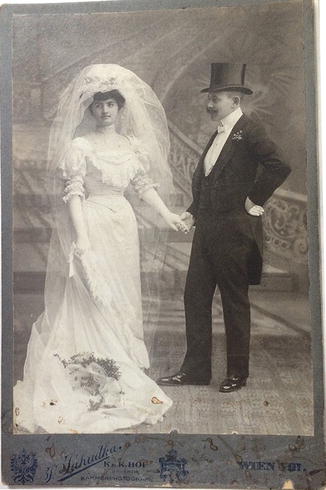
Berta (Monias) and Heinrich Offenberger, Vienna, 1909 (Credit: Fred and Helena Altstadt, Argentina)
Now I see the IKG completely different. What they have done for the Jews of Vienna with efficiency, bravery and endless resilience, in the face of a deadly foe, is a miracle.
(Dr. Nikolaus Mayer, Vienna, September 2015)
Edith Kurzweil fled Vienna on a Kindertransport in 1938. She was one of approximately 200,000 Austrian Jews who fell victim to the sudden terror of Nazism unleashed after Anschluss and 136,000 to escape from the Nazi web before the genocide began. Fortuitous circumstance spared Edith from murder but did not shield her from the scars of family division and permanent separation. Nor did her escape guarantee any security for the future. While Kurzweil managed to get out of Vienna, Vienna never left her. She managed to flee from Europe and to escape the Holocaust, but too many of her loved ones and members of the community from which she came, did not. After the war, Kurzweil did not go home to Vienna, for Vienna was no longer home to her. The Nazis had destroyed that possibility.Edith Kurzweils experience as a Viennese migr mirrors thousands of others who managed to escape from the Greater German Reich during the Nazi period, but not without terrible loss. Seven decades later, still suffering from the absence of Heimat and looking to resolve unanswered questions about her past, Kurzweil began to analyze correspondence between her mother in New York and grandmother in Vienna from April 1940 through November 1941. nor offered a comprehensive analysis of the short- and long-term effects of Nazism on the Jewish community of Vienna at large.
The Jews of Nazi Vienna, 19381945: Rescue and Destruction is the work Kurzweil envisioned. This book explores the daily life of Jews in Nazi Vienna before, during, and after the Anschluss of March 1938 up through the mass deportations of 1942 and the disintegration of the community that followed. By examining the histories of numerous ordinary Viennese Jews (and their families) and placing them into a chronological narrative of life in Vienna under Nazi occupation, it unpacks the simultaneous rescue and destruction of this community, step by step. Like Kaplans analysis of daily life for German Jews under Nazism, this work reveals the social death from which Austrian Jews suffered prior to, during, and after the genocide.
Representations of the Holocaust, in history, literature, art, and memorials, tend to focus on the genocidal periodthe death camps, gas chambers, and mass murders. Yet as we are well aware, the destruction of Jewish communities, Jewish families, and Jewish individual lives did not begin in the death camps; it ended there. As Marion Kaplan so carefully documented in her work on German Jewish responses to Nazism between 1933 and 1939, Jews suffered from social death years before the Nazis drew up the final solution. So too, in Vienna, did they suffer from this social death. Today, a visitor in Vienna may stumble upon artist Alfred Hrdlickas dedication to the street washing Jew while walking through the citys first district or making a visit to the popular Albertina museum. Hrdlickas memorial, like Kaplans literary analysis, draws our attention to the attacks on Jewish life that occurred years prior to the Final Solution. The sculpture reminds viewers of the inhumanity and injustice that took over in the public squares and busy streets of Vienna in March 1938; of a time when neighbors turned a blind eye to the suffering of their neighbors, and the social contract between Viennas Jews and their government shattered. Like Hrdlinkas artistic composition and Kaplans careful study of German Jewry, this work spotlights the early years of the Nazi occupation in Vienna, begging its readers to scrutinize the causes and effects of hatred and question its possible outcomes.
Font size:
Interval:
Bookmark:
Similar books «The Jews of Nazi Vienna, 1938-1945: Rescue and Destruction»
Look at similar books to The Jews of Nazi Vienna, 1938-1945: Rescue and Destruction. We have selected literature similar in name and meaning in the hope of providing readers with more options to find new, interesting, not yet read works.
Discussion, reviews of the book The Jews of Nazi Vienna, 1938-1945: Rescue and Destruction and just readers' own opinions. Leave your comments, write what you think about the work, its meaning or the main characters. Specify what exactly you liked and what you didn't like, and why you think so.

